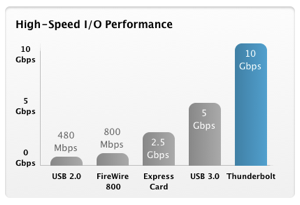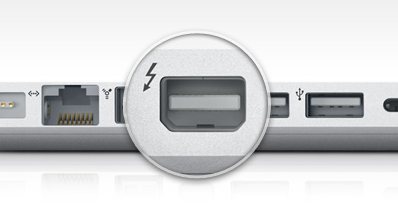
Intel has finally launched its new peripheral interconnect technology—formerly codenamed "Light Peak"—now branded "Thunderbolt." Developed in cooperation with Apple, which introduced Thunderbolt on its newest MacBook Pro laptops on Thursday morning, the new interconnect is designed to bring workstation-class I/O throughput to mobile workflows as well as serve as a next-generation connector for peripherals, including displays, storage, and video and audio devices.
Intel first announced Light Peak at the Intel Developers Forum in 2009. The proposed standard was intended to replace interconnects like FireWire, USB, and others with fiber optic connections capable of up to 100Gbps bi-directional throughput. Moving to fiber instead of copper allowed increased speeds as well as dramatically longer cable runs. The original demos used a 30m fiber optic cable to transmit dual 1080p video streams, LAN traffic, and files to an SSD RAID setup.
In its initial out-of-the-lab incarnation, Thunderbolt can use either copper or fiber connections for 10Gbps bidirectional communication. That speed is 20 times faster than the theoretical limit of USB 2.0, 12 times faster than FireWire 800, and twice as fast as USB3. According to Intel, however, the 10Gbps isn't just a theoretical peak speed, but usable bandwidth. This allows a single port to communicate with multiple devices simultaneously for a combined throughput of 10Gbps.

That 10Gbps is much faster than most current I/O technologies. With two devices pushing data at the maximum rate, you could back up a full Blu-ray movie in 30 seconds, or sync 64GB of music to a portable device in about a minute. Copying the entire contents of the Library of Congress in digital form—approximately 20TB of data—would take about 35 minutes.
Active electrical-only cables can be up to 3 meters (just under 10 feet) in length, similar to current FireWire and USB standards. Active optical cables, which use fiber for data transmission and copper for up to 10W of power, can be "tens of meters" in length. Passive fiber-only cables could potentially be hundreds of meters long. These lengths enable more flexible positioning between devices and computers instead of relying on specialized connections or relatively pokey wireless solutions.
Thunderbolt uses the Mini DisplayPort connector pioneered by Apple for physical connections; future versions will presumably incorporate optical connections, but the current generation released in Apple's MacBook Pros is purely electrical. Apple was not able to clarify to us how optical cables could be used with the ports on the new MacBook Pros, but an Intel press conference scheduled for this afternoon promised to offer more technical details.

Because each Thunderbolt device will include a tiny Intel-made controller, similar to FireWire, multiple Thunderbolt devices can be daisy-chained to a single port and can communicate directly peer-to-peer. It doesn't require hubs like USB does, nor does it depend on the CPU to initiate and handle device communication. Also like FireWire, Thunderbolt ports can supply power to connected devices—up to 10W total per port. Furthermore, powered devices in the chain can pass 10W of power further down the chain if needed.
Thunderbolt supports both DisplayPort and PCI Express protocols over its 10Gbps transport layer. A major benefit of this design is that Thunderbolt devices can leverage native OS drivers for PCI Express and DisplayPort for compatibility—no additional drivers are needed. Existing Mini DisplayPort-equipped monitors are already compatible and can be plugged in directly, and Mini DisplayPort adapters for VGA, DVI, or HDMI will also work. Intel said that adapters can be made using a Thunderbolt controller and common PCI bridges to adapt existing FireWire, USB, eSATA, and even Ethernet connectors.
Intel's controllers handle all the necessary protocol switching between PCI Express and DisplayPort, which enables simultaneous transmission of data via both protocols over the same cable. The controllers are also optimized for extremely low-latency communication with quality-of-service support, which is critical for handling pro video and audio applications. Connected devices can be clock-synchronized to within 8 nanoseconds.

The combination of a compact, inexpensive controller with the tiny Mini DisplayPort makes Thunderbolt particularly suited to mobile computing. In particular, thin and light ultraportable laptops like the MacBook Air and Sony Vaio S series could connect to a high-performance audio controller for recording, a RAID for nearly instantaneous backups, and an external HD monitor—all from a single port.
Though Apple was instrumental in initiating the Light Peak project and was involved in Thunderbolt's development, the company maintained that Thunderbolt is Intel's technology, so it shouldn't be relegated to just Apple's systems. Besides Apple, Intel has convinced a number of companies to pledge support for the Thunderbolt standard. A couple storage vendors, including Promise Technology, are expected to announce compatible products Thursday that are set to ship this spring. The full list of those planning Thunderbolt support in future products include AJA, Apogee, Avid, Blackmagic, Universal Audio, LaCie, and Western Digital. Given the clear technical advantages over previous standards, we believe Thunderbolt could achieve wide industry adoption.
reader comments
422